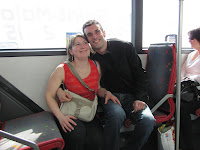

Our last five days in France, we were back in Paris, this time in the Montparnasse district.
A couple of days before leaving California, I had learned that the hotel I had reserved on the right bank was in a redlight district. Panicking, I opted for more expensive and left bank Montparnasse, figuring that after 4.5 weeks we might want a bit less of La Boheme. It was a lot more expensive, but hotels were filling fast so I grabbed the cheapest room at the Villa Luxembourg while I could.
Montparnasse: The name stems from the nickname “Mount Parnassus" (in Greek mythology, home to the nine Greek goddesses – the Muses – of the arts and sciences) given to the hilly neighbourhood in the 17th century by students who came there to recite poetry [from Wikipedia].
Wait! I’m off track! I want to tell you about the Boy in the Blue Hat!
About ¾ mile from our hotel was Le Jardin du Luxembourg (gardens, playgrounds, palace, etc.). Every morning while Mary finished sleeping and making up, I would amble over there for an hour or more of blissful reflection. Up Blvd. Montparnasse I strolled, turning left on the street by the fountain at the Place Observatoire, going alongside the long narrow parks where children play and dogs are forbidden, past the College of Pharmacy, and finally entering the garden through the tall ornate metal gates. I wandered in a timeless world where tree-shaded, chair-lined, wide paths criss-crossed the immense palace grounds. It would be early enough for most Parisians to still be abed, having been up late the night before, so only gardeners and joggers joined me there. After meandering along various paths for awhile, I would usually end up at the area dominated by two sculptures, one of a deer family with buck rising majestically over doe and fawns, and the other o f a male lion majestically rising over his kill, an ostrich. Every day I thought, “How odd. An ostrich.”
f a male lion majestically rising over his kill, an ostrich. Every day I thought, “How odd. An ostrich.”
One morning I sat longer than usual, eventually closing my eyes so I could hear the songs of the birds more clearly. I probably dozed as the morning sunrise warmed the air, because I remember becoming aware of whistling in the distance. The tune was gay, like something from the romantic 19th Century rather than our own prosaic one. Curious, but also reluctant to be disappointed, I slowly opened my eyes to search for the whistler.
Across the grass, farther than the next path, and just beyond the border of green trees, danced a young boy in a blue cap, twirling, leaping, pirouetting, flying in and out of the long morning shadows – while his unseen companion whistled and another contributed marvelous tinkling bubbly laughter that filled the air with bright sparkling light.
Watch them and don’t breathe!
I tried to imprint them on my eyes, in my ears, so as to have them forever in my heart.
Try to hold onto them a moment longer while I tell you another story about Luxembourg. When I got home, I was rushing through an online catalog of Impressionistic paintings from around 1900-1910. Suddenly my eyes stopped to stare at a singular one. When my brain detoured back to it, I saw my chair in the Luxembourg Gardens right where the Lion rises over the Ostrich! Someone was sitting in my chair, a lady from another century clothed in black, but otherwise the scene was exactly as it was for me in the mornings of my last five days in Paris.
Was there a Boy in a Blue Cap in the painting, just beyond the row of trees? I hope so. I hope boys will always feel free enough and happy enough to dance through the gardens, laughing and whistling while the world swirls around them.
[Unfortunately, hours of searching for that image to share with you have produced nothing. The best I could do was the one of the deer where the trees are still leafless - news-e.hoosta.com - not full of green like they were that early week in May.]
I know I promised more of St. Malo for this blog, but the boy in the blue hat wanted to be remembered. Next time, back to St. Malo!
















